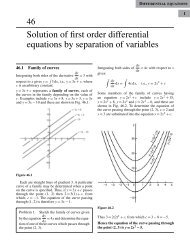differentiation
Create successful ePaper yourself
Turn your PDF publications into a flip-book with our unique Google optimized e-Paper software.
292 DIFFERENTIAL CALCULUS<br />
27.4 Differentiation of a product<br />
When y = uv, and u and v are both functions of x,<br />
then<br />
dy<br />
dx = udv dx + vdu dx<br />
This is known as the product rule.<br />
Problem 10. Find the differential coefficient of<br />
y = 3x 2 sin 2x.<br />
3x 2 sin 2x is a product of two terms 3x 2 and sin 2x<br />
Let u = 3x 2 and v = sin 2x<br />
Using the product rule:<br />
gives:<br />
i.e.<br />
dy<br />
dx = u dv<br />
dx<br />
du<br />
+ v<br />
dx<br />
↓ ↓ ↓ ↓<br />
dy<br />
dx = (3x2 )(2 cos 2x) + (sin 2x)(6x)<br />
dy<br />
dx = 6x2 cos 2x + 6x sin 2x<br />
= 6x(xcos 2x + sin 2x)<br />
Note that the differential coefficient of a product<br />
is not obtained by merely differentiating each term<br />
and multiplying the two answers together. The product<br />
rule formula must be used when differentiating<br />
products.<br />
Problem 11. Find the rate of change of y with<br />
respect to x given y = 3 √ x ln 2x.<br />
The rate of change of y with respect to x is given<br />
by dy<br />
dx<br />
y = 3 √ x ln 2x = 3x 1 2 ln 2x, which is a product.<br />
Let u = 3x 2 1 and v = ln 2x<br />
dy<br />
Then<br />
dx = u dv<br />
du<br />
+ v<br />
dx<br />
dx<br />
( ↓ )( ↓)<br />
↓ [ ( ↓ ]<br />
= 3x 2<br />
1 1 1<br />
+ (ln 2x) 3 x 2<br />
x 2) 1 −1<br />
(<br />
= 3x 2 1 −1 3<br />
+ (ln2x) x<br />
2)<br />
− 2<br />
1<br />
i.e.<br />
= 3x − 2<br />
(1 1 + 1 )<br />
2 ln 2x<br />
dy<br />
dx = √ 3 (<br />
1 + 1 )<br />
x 2 ln 2x<br />
Problem 12. Differentiate y = x 3 cos 3x ln x.<br />
Let u = x 3 cos 3x (i.e. a product) and v = ln x<br />
dy<br />
Then<br />
dx = udv dx + vdu dx<br />
where du<br />
dx = (x3 )(−3 sin 3x) + (cos 3x)(3x 2 )<br />
and<br />
dv<br />
dx = 1 x<br />
Hence dy<br />
dx = (x3 cos 3x)<br />
( 1<br />
x<br />
i.e.<br />
)<br />
+ (ln x)[−3x 3 sin 3x<br />
+ 3x 2 cos 3x]<br />
= x 2 cos 3x + 3x 2 ln x(cos 3x − x sin 3x)<br />
dy<br />
dx = x2 {cos 3x + 3lnx(cos 3x − x sin 3x)}<br />
Problem 13. Determine the rate of change of<br />
voltage, given v = 5t sin 2t volts when t = 0.2s.<br />
Rate of change of voltage = dv<br />
dt<br />
= (5t)(2 cos 2t) + ( sin 2t)(5)<br />
= 10t cos 2t + 5 sin 2t<br />
When t = 0.2, dv<br />
dt = 10(0.2) cos 2(0.2) + 5 sin 2(0.2)<br />
= 2 cos 0.4 + 5 sin 0.4 (where cos 0.4<br />
means the cosine of 0.4 radians)<br />
Hence dv = 2(0.92106) + 5(0.38942)<br />
dt<br />
= 1.8421 + 1.9471 = 3.7892<br />
i.e., the rate of change of voltage when t = 0.2 s is<br />
3.79 volts/s, correct to 3 significant figures.










